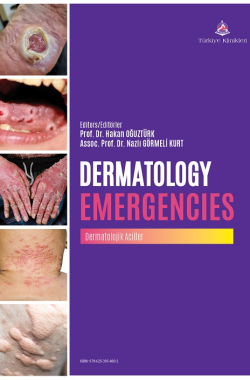Erysipelas
Adem AZ
University of Health Sciences Faculty of Medicine, Haseki Training and Research Hospital, Department of Emergency Medicine, İstanbul, Türkiye
Az A. Erysipelas. In: Oğuztürk H, Görmeli Kurt N, eds. Dermatologic Emergencies. 1st ed. Ankara: Türkiye Klinikleri; 2025. p.11-4.
ABSTRACT Erysipelas is a bacterial skin infection that primarily affects the upper dermis and extends to the superficial lymphatic veins. It is a specific form of cellulitis, typically characterized by sharply de- marcated, erythematous, and indurated plaques, most commonly affecting the lower extremities and the face. The primary causative agent is Group A Streptococcus, although other streptococci and staphylococci may be implicated. Early symptoms include malaise, fever, and a fiery red skin lesion with welldefined borders. The infection can progress rapidly, necessitating prompt antibiotic treatment, typically with penicillin or amoxicillin, to prevent complications, particularly in high-risk groups such as the el- derly, infants, and immunocompromised individuals. Diagnosis is primarily clinical, based on physical examination and medical history, with laboratory tests used in complicated cases. While most cases respond well to outpatient antibiotic therapy, severe infections may require hospitalization and intensive care. This section covers the current understanding of erysipelas, its clinical features, risk factors, diag- nostic criteria, treatment options, and preventive strategies.
Keywords: Erysipelas; diagnosis; prevention; therapy
Kaynak Göster
Referanslar
- Stevens DL. Cellulitis, pyoderma, abscesses and other skin and subcutaneous infections. In: Cohen J, Opal SM, Powderly WG, eds. Infectious Diseases. 3rd ed. Mosby; 2010. p.109-18. [Crossref]
- Phoenix G, Das S, Joshi M. Diagnosis and management of cellulitis. BMJ. 2012;345:e4955. [Crossref] [PubMed]
- Asensi V, Asensi JM. Saint Anthony's Fire. JAMA Dermatol. 2016;152(7):850. [Crossref] [PubMed]
- Bonnetblanc JM, Bédane C. Erysipelas: recognition and management. Am J Clin Dermatol. 2003;4(3):157-63. [Crossref] [PubMed]
- Stevens DL, Bisno AL, Chambers HF, Dellinger EP, Goldstein EJ, Gorbach SL, et al. Practice guidelines for the diagnosis and management of skin and soft tissue infections: 2014 update by the Infectious Diseases Society of America. Clin Infect Dis. 2014;59(2):e10-52. [Crossref] [PubMed]
- Bernard P. Management of common bacterial infections of the skin. Curr Opin Infect Dis. 2008;21(2):122-8. [Crossref] [PubMed]
- Rath E, Skrede S, Mylvaganam H, Bruun T. Aetiology and clinical features of facial cellulitis: a prospective study. Infect Dis (Lond). 2018;50(1):27-34. [Crossref] [PubMed]
- Karakonstantis S. Is coverage of S. aureus necessary in cellulitis/erysipelas? A literature review. Infection. 2020;48(2):183-91. [Crossref] [PubMed]
- Morris AD. Cellulitis and erysipelas. BMJ Clin Evid. 2008;2008:1708. [Link]
- Pereira de Godoy JM, Galacini Massari P, Yoshino Rosinha M, Marinelli Brandão R, Foroni Casas AL. Epidemiological data and comorbidities of 428 patients hospitalized with erysipelas. Angiology. 2010;61(5):492-4. [Crossref] [PubMed]
- Klotz C, Courjon J, Michelangeli C, Demonchy E, Ruimy R, Roger PM. Adherence to antibiotic guidelines for erysipelas or cellulitis is associated with a favorable outcome. Eur J Clin Microbiol Infect Dis. 2019;38(4):703-9. [Crossref] [PubMed]
- Ellis Simonsen SM, van Orman ER, Hatch BE, Jones SS, Gren LH, Hegmann KT, et al. Cellulitis incidence in a defined population. Epidemiol Infect. 2006;134(2):293-9. [Crossref] [PubMed] [PMC]
- Michael Y, Shaukat NM. Erysipelas. In: StatPearls [Internet]. Treasure Island (FL): StatPearls Publishing; 2024. [Accessed at: 4 August 2024] [Accessed on: ] [Link]
- Taniguchi T, Tsuha S, Shiiki S, Narita M, Teruya M, Hachiman T, et al. High Yield of Blood Cultures in the Etiologic Diagnosis of Cellulitis, Erysipelas, and Cutaneous Abscess in Elderly Patients. Open Forum Infect Dis. 2022;9(7):ofac317. [Crossref] [PubMed] [PMC]
- Gunderson CG, Martinello RA. A systematic review of bacteremias in cellulitis and erysipelas. J Infect. 2012;64(2):148-55. [Crossref] [PubMed]
- Lewis DL, Butts CJ, Moreno-Walton L. Facing the danger zone: the use of ultrasound to distinguish cellulitis from abscess in facial infections. Case Rep Emerg Med. 2014;2014:935283. [Crossref] [PubMed] [PMC]
- Brindle R, Williams OM, Barton E, Featherstone P. Assessment of Antibiotic Treatment of Cellulitis and Erysipelas: A Systematic Review and Meta-analysis. JAMA Dermatol. 2019;155(9):1033-40. [Crossref] [PubMed] [PMC]
- Ferreira A, Bolland MJ, Thomas MG. Meta-analysis of randomised trials comparing a penicillin or cephalosporin with a macrolide or lincosamide in the treatment of cellulitis or erysipelas. Infection. 2016;44(5):607-15. [Crossref] [PubMed]
- Henry F, Salomon-Neira MD, Letot B, Piérard-Franchimont C, Piérard GE. How I prevent erysipelas and its consequences and recurrences. Rev Med Liege. 2004;59(7-8):423-5. French. [PubMed]
- Oh CC. Cellulitis and erysipelas: prevention. BMJ Clin Evid. 2015;2015:1708. [PubMed]

